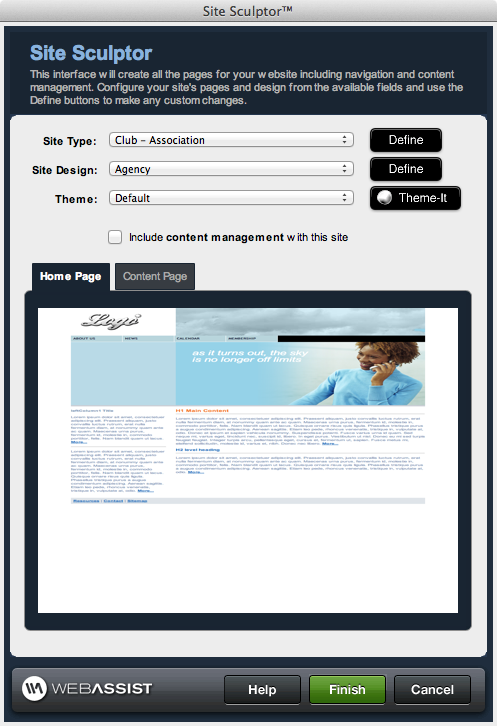Choose Your Site's Settings
The primary interface for Site Sculptor allows you to choose the type of site you intend to create and select the design for your website.
From this interface you can determine the general settings for your entire site, as well as launch interfaces for making custom changes to your site's pages and design.
Site Type: From this list, choose the type of site that is most similar to the site you are creating.
Your Site Type selection will determine which pages are created in your site.
Site Design: Choose the design you wish to use for your website.
Refer to the preview below, and the Home Page and Content Page tabs to see samples of how your site's pages will appear.
Theme: If you have saved any custom designs, your theme will be available from here.
Each Site Design will have a Default theme when you first install Site Sculptor.
 |
The following buttons are provided to allow you to further customize the pages and design of your site. Site Type: Opens the Site Type interface for customizing your website's pages and navigation. Site Design: Opens the interface for creating new Site Sculptor designs based on your own custom templates. Theme-It: Launches the Theme-It interface for customizing the colors and images used in your site's design.
Include content management with this site When selected, the built-in content management feature of Site Sculptor will be included with your site.* *Requires that Site Sculptor create PHP. For more information click here.
Click Finish when you are ready to have Site Sculptor create all your site's pages. |
What do I need to know about using PHP pages?
PHP pages are required in order to include content management with your site. In most cases, this will not be a problem, but you will need to understand what the limitations that you may come across.
- Browsing PHP pages on your local computer
PHP pages cannot be viewed on a typical computer without setting up a PHP testing server. For most Site Sculptor users, this will not be a problem since you need to upload your site's files to your live (hosting provider's) server before you can set up the content management. Your hosting provider will most likely be running a PHP server by default.